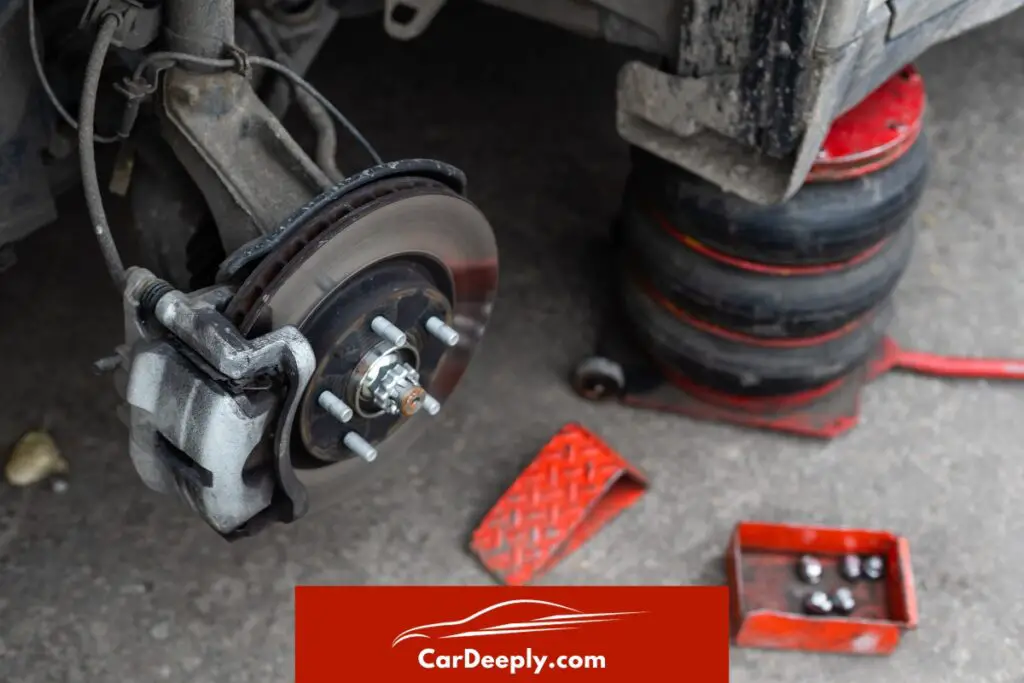Navigating the maze of tools needed for a brake job on your Ford F-150 can be daunting, but you’re in the right place to simplify that journey. With years of automotive expertise, we’ve pinpointed the exact tools and techniques you’ll need.
No more second-guessing or unnecessary trips to the auto store. In this comprehensive guide, you’ll discover:
- The indispensable C-clamp technique for caliper compression.
- How to use a torque wrench for precise lug nut tightening.
- The role of a brake cleaner spray in enhancing brake longevity.
So, are you ready to tackle your Ford F-150’s brake job like a pro? Read on to find out how.
Advertising links are marked with *. We receive a small commission on sales, nothing changes for you.
Key Takeaways

- Regular brake maintenance is essential for the safety and longevity of your Ford F150.
- A comprehensive list of tools, including a C-clamp and torque wrench, is crucial for a successful brake job.
- Tools like high-temperature grease and rotor cleaner enhance the brake job’s effectiveness.
- Step-by-step guidelines provide practical work instructions for changing brake pads and other components.
- Pro tips offer insights into avoiding common mistakes and when to seek professional help.
Introduction and Basic Tools
Why Brake Maintenance is Crucial for Your Ford F150
Regular brake maintenance isn’t just a recommendation; it’s necessary, especially for a high-performance vehicle like the Ford F150. Ignoring the signs of wear and tear on your brake system can lead to disastrous consequences for your vehicle and your safety. So, what are these signs?
- Squeaking or Squealing Noise: If you hear a high-pitched noise when you apply the brakes, it indicates that your brake pads are worn out.
- Vibration in the Steering Wheel: A vibrating steering wheel, when braking, usually signifies warped rotors.
- Reduced Responsiveness: If the brake pedal sinks more than usual, you might be looking at a leak in the brake system.
By regularly checking these signs and performing timely brake maintenance, you can extend the lifespan of your Ford F150’s brake system and ensure a safer driving experience.
List of Essential Tools for a Brake Job on Ford F150
Alright, let’s get down to business. You’re here because you want to know exactly what tools you’ll need for a brake job on a Ford F150. We’ve got you covered.
Jack and Tire Iron
First, you’ll need a jack to lift your Ford F150 off the ground. Make sure it has a lifting capacity that matches or exceeds your vehicle’s weight, which is approximately 4,000 to 5,316 pounds, depending on the model.
- Step 1: Place the jack under the vehicle’s designated lift points.
- Step 2: Use the tire iron to slightly loosen the lug nuts before lifting the car.
C-Clamp
A C-Clamp is indispensable for compressing the brake caliper, making removing the old brake pads and installing new ones easier.
- Step 1: Open the C-Clamp wide enough to fit over the caliper.
- Step 2: Turn the screw on the C-Clamp until the caliper is compressed.
13mm Wrench for Caliper Bolts
You’ll need a 13mm wrench to remove the bolts holding the brake caliper.
- Step 1: Locate the caliper bolts.
- Step 2: Use the 13mm wrench to loosen and remove them.
Additional Tools
- 18mm Socket and Pull Bar for Caliper Mount Bracket: Essential for removing the caliper mount bracket.
- Adjustable Wrench for Wheel Bearings Retainer Nut: Needed for adjusting the wheel bearings.
- Pliers for Cotter Key: Remove the cotter key that secures the retainer nut.
- Grease Seal Puller and Installer: For removing and installing the grease seal.
- Torque Wrench: For tightening the lug nuts to the correct torque, usually between 100-150 ft-lbs for a Ford F150.
- Rags and Brake Cleaner: To clean the brake components before reassembly.
By having these tools at your disposal, you’re not just saving time but also ensuring that your brake job is performed to the highest standard.
You might need all these tools when setting one of five best brake pads in your F150!
So, are you ready to move on to some advanced tools and tips? Keep reading!
Advanced Tools and Tips
Additional Tools for a Comprehensive Brake Job
You’ve got the basics down, but a thorough brake job on your Ford F150 requires a few more specialized tools. These aren’t just bells and whistles; they’re the key to a well-done job.
Grease for Packing the Bearings
Wheel bearings need to be well-lubricated to function correctly. For this, you’ll need high-temperature wheel bearing grease.
- Step 1: Clean the old grease off the bearings using a rag.
- Step 2: Apply a generous amount of new grease, ensuring it penetrates the bearings.
Rotor Cleaning Supplies
A clean rotor surface is crucial for optimal brake performance. You’ll need a wire brush and rotor cleaner for this.
- Step 1: Use the wire brush to remove any rust or debris.
- Step 2: Spray the rotor cleaner and wipe it down with a clean rag.
Dust Cap Remover
The dust cap protects the wheel bearings and grease seal. You’ll need a specialized tool to remove it without causing damage.
- Step 1: Insert the dust cap remover under the edge of the cap.
- Step 2: Gently pry the cap off, careful not to deform it.
Step-by-Step Guide to Changing Front Brake Pads
Changing the brake pads is the cornerstone of any brake job. Let’s dive into the nitty-gritty details.
Preparing the Vehicle
- Step 1: Park your Ford F150 on a flat surface.
- Step 2: Use wheel chocks to secure the vehicle.
Removing the Wheel
- Step 1: Loosen the lug nuts with a tire iron.
- Step 2: Lift the vehicle using a jack and remove the lug nuts altogether.
Removing and Replacing the Brake Pads
- Step 1: Use the 13mm wrench to remove the caliper bolts.
- Step 2: Slide out the old brake pads and slide in the new ones.
Reassembling and Testing
- Step 1: Reattach the caliper and tighten the bolts.
- Step 2: Lower the vehicle and tighten the lug nuts to a torque of 100-150 ft-lbs.
Pro Tips for a Successful Brake Job
You’re almost there, but consider these pro tips to elevate your brake job from good to great before you wrap up.
Avoid Common Mistakes
- Over-tightening Lug Nuts: Use a torque wrench to avoid this.
- Ignoring the Brake Fluid: Always check and top up if necessary.
Ensure the Longevity of Your New Brake Pads
- Break-in Period: Drive cautiously for the first 50-100 miles to allow the new brake pads to settle in.
When to Seek Professional Help
If you encounter issues like leaking brake fluid or persistent squealing noise, it’s time to consult a professional.
By adhering to these guidelines and using the right tools, you’re setting yourself up for a successful and safe brake job on your Ford F150. Ready to put your newfound knowledge to the test?
Frequently Asked Questions
Can I Use Regular Grease Instead of High-Temperature Wheel Bearing Grease?
No, using high-temperature wheel-bearing grease specifically designed for automotive applications is crucial. Regular grease may not withstand the heat generated during braking, compromising the wheel bearings’ performance and longevity.
Is It Necessary to Replace the Brake Fluid When Doing a Brake Job?
While the main focus is often on brake pads and rotors, checking the brake fluid levels is advisable. Old or contaminated brake fluid can affect the brake system’s responsiveness and should be replaced if needed.
What Are the Signs That My Brake Rotors Need to Be Replaced?
If you notice vibrations when braking or hear a grinding noise, these could be signs of worn-out or warped rotors. Inspecting the rotors during your brake job is best to determine if they need replacement.
How Often Should I Perform a Brake Job on My Ford F150?
The frequency of brake jobs depends on your driving habits and conditions. However, inspecting your brake system every 12,000 to 15,000 miles is a good practice to ensure optimal performance.
Can I Perform a Brake Job, or Should I Seek Professional Help?
If you have the right tools and follow the guidelines meticulously, performing a brake job yourself is feasible. However, it’s best to consult a professional if you encounter issues like persistent squealing or leaking brake fluid.

Luna Meschiari is a full-blooded car nut who is well known to local garages, as each article is meticulously researched and peppered with the latest piece of information. Guess what car she’s driving right now? A RAV4 2021 Hybrid. But her heart also sleeps for pickups like the F-150. Get to know Luna better on the about us page.
Advertising links are marked with *. We receive a small commission on sales, nothing changes for you.
